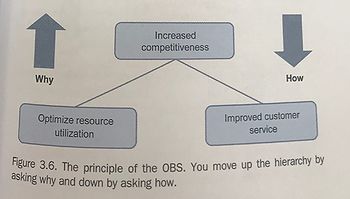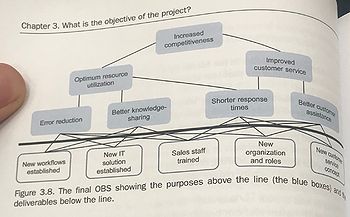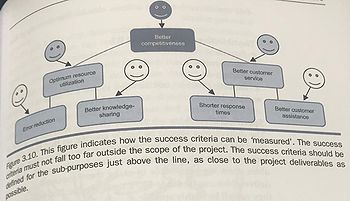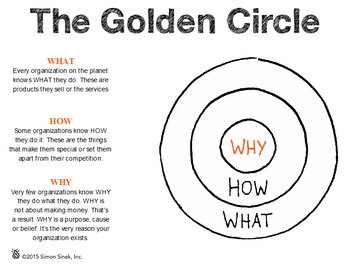Goal hierarchy or Goal Breakdown Structure
(→How to create a goal heirarchy by using GBS) |
|||
| (5 intermediate revisions by one user not shown) | |||
| Line 15: | Line 15: | ||
[[Image:GBS1.jpg | right|thumb| 350px | Figure 3.6, Attrup and Olsson. The figure displayhow to "flesh out the porpuse" by asking how and why.]] | [[Image:GBS1.jpg | right|thumb| 350px | Figure 3.6, Attrup and Olsson. The figure displayhow to "flesh out the porpuse" by asking how and why.]] | ||
[[Image:GBS2.jpg | right|thumb| 350px | Figure 3.8, Attrup and Olsson. The black line seperates the purpose from the deliverables. ]] | [[Image:GBS2.jpg | right|thumb| 350px | Figure 3.8, Attrup and Olsson. The black line seperates the purpose from the deliverables. ]] | ||
| − | [[Image:GBS3.jpg | right|thumb| 350px | Figure 3.10, Attrup and Olsson. The smilies indicate which goals are suitable to create success criteria. (White is best and dark is | + | [[Image:GBS3.jpg | right|thumb| 350px | Figure 3.10, Attrup and Olsson. The smilies indicate which goals are suitable to create success criteria. (White is best and dark is worse).]] |
The book “Power in Projects, Programs and Portfolios” by Attrup and Olsson (2015) <ref> Attrup, M. L. and Olsson, J.R. , Power in Projects, Programs and Portfolios, DJØF Publishing (30 Sept. 2015), ISBN-10: 8757434093.</ref> provides a thorough explanation and example of how to create a GBS. The authors refer to goals as objectives and therefore the book refers to GBS as an objective break down structure or OBS. This article will use the term GBS. | The book “Power in Projects, Programs and Portfolios” by Attrup and Olsson (2015) <ref> Attrup, M. L. and Olsson, J.R. , Power in Projects, Programs and Portfolios, DJØF Publishing (30 Sept. 2015), ISBN-10: 8757434093.</ref> provides a thorough explanation and example of how to create a GBS. The authors refer to goals as objectives and therefore the book refers to GBS as an objective break down structure or OBS. This article will use the term GBS. | ||
| Line 35: | Line 35: | ||
==The golden circle== | ==The golden circle== | ||
| − | [[Image:TGC.png | right|thumb| 350px ]] | + | [[Image:TGC.png | right|thumb| 350px | Figure 4, CC S.Sinek 2015, "The golden circle".]] |
| − | A more condensed version of the application of GBS is presented in Sinek’s book “Start with Why”. He presents a model of ordering the question why, how and what in a circular diagram, which he refers to as “the golden circle”. <ref> Simon Sinek, Start With Why: How Great Leaders Inspire Everyone To Take Action, Penguin UK, 6 okt. 2011 </ref> See figure | + | A more condensed version of the application of GBS is presented in Sinek’s book “Start with Why”. He presents a model of ordering the question why, how and what in a circular diagram, which he refers to as “the golden circle”. <ref> Simon Sinek, Start With Why: How Great Leaders Inspire Everyone To Take Action, Penguin UK, 6 okt. 2011 </ref> See figure 4. |
Similar to the GBS model, the highest level of the purpose is reached by asking the question why. The question how implies how a business achieve their main purpose or products, i.e. the sub-goals. The what question, represents what the business delivers i.e. the deliverables. | Similar to the GBS model, the highest level of the purpose is reached by asking the question why. The question how implies how a business achieve their main purpose or products, i.e. the sub-goals. The what question, represents what the business delivers i.e. the deliverables. | ||
Sinek (2011) further defines the three levels of questions in the golden circle and argues that every organization knows what they do and what products or services they sell. He highlights, some organisations know how they do it. This level represents how they set their business apart from their competitors. Finally, he states that very few businesses know why they do what they do and he defines the why level with the utmost importance to great business success. He writes; ''“WHY is not about making money. That’s a result. WHY is a purpose, cause or belief. It’s the very reason your organization exists.'' “ <ref> Simon Sinek, Start With Why: How Great Leaders Inspire Everyone To Take Action, chapter 3, Penguin UK, 6 okt. 2011 </ref>. He argues, that the need to know why a company does what they do is a biological definitive of how the human mind chooses what it likes. | Sinek (2011) further defines the three levels of questions in the golden circle and argues that every organization knows what they do and what products or services they sell. He highlights, some organisations know how they do it. This level represents how they set their business apart from their competitors. Finally, he states that very few businesses know why they do what they do and he defines the why level with the utmost importance to great business success. He writes; ''“WHY is not about making money. That’s a result. WHY is a purpose, cause or belief. It’s the very reason your organization exists.'' “ <ref> Simon Sinek, Start With Why: How Great Leaders Inspire Everyone To Take Action, chapter 3, Penguin UK, 6 okt. 2011 </ref>. He argues, that the need to know why a company does what they do is a biological definitive of how the human mind chooses what it likes. | ||
| Line 59: | Line 59: | ||
=Limitations= | =Limitations= | ||
| − | One limitation or problem that can arise while creating the goal hierarchy by asking how and why, is that groups can find them selves the question why to much. When asking why to much and increasing the abstraction level, groups can find them selves asking almost existential questions. These questions are interesting but they are not that quantifiable and interesting to govern a business after. Attrup and Olsson state “''if you continue to ask why, however, you end up with, ‘Why are we here?’, ‘What is the meaning of life?’… and this can be difficult to navigate by”.'' | + | One limitation or problem that can arise while creating the goal hierarchy by asking how and why, is that groups can find them selves the question why to much. When asking why to much and increasing the abstraction level, groups can find them selves asking almost existential questions. These questions are interesting but they are not that quantifiable and interesting to govern a business after. Attrup and Olsson state “''if you continue to ask why, however, you end up with, ‘Why are we here?’, ‘What is the meaning of life?’… and this can be difficult to navigate by”.'' <ref> Attrup, M. L. and Olsson, J.R. , Power in Projects, Programs and Portfolios, page 107, DJØF Publishing (30 Sept. 2015), ISBN-10: 8757434093 </ref> |
Another limitation of the goal setting strategy is that it relies on a purpose that is properly defined and at reasonable level of scope, to begin with. Otherwise, moving down the goal hierarchy by asking how, can be next to impossible to do. How do we create world peace? | Another limitation of the goal setting strategy is that it relies on a purpose that is properly defined and at reasonable level of scope, to begin with. Otherwise, moving down the goal hierarchy by asking how, can be next to impossible to do. How do we create world peace? | ||
Latest revision as of 21:43, 4 March 2019
Contents |
[edit] Abstract
Purpose is the reason why a project exists. However, the purpose of a project, program or portfolio (PPP) needs to be crystallised in to a desirable strategy to generate the intended benefits. The goal hierarchy or goal breakdown structure helps to transform and break down a PPP's purpose into more manageable goals, sub-goals, and deliverables, while maintaining a clear connection to the PPP's main purpose. The aspect of creating a clear goal hierarchy is applicable and is important in projects, programs and portfolios. The PMI standard for program management describes the process of creating a goal hierarchy as “goal setting” by “To facilitate alignment and goal setting, the organization’s strategic plan is further delineated as a set of goals and objectives that may have measurable elements such as products, deliverables, benefits, cost, and timing, among others. The goal of linking the program to the organization’s strategic plan is to plan and manage a program that will help the organization achieve its strategic goals and objectives and to balance its use of resources while maximizing value.” [1] . This statement both displays a method of crystallising the main goal in to a structure of more concrete lower level sub goals of products, benefits, deliverables and so forth. The statement also exemplifies that the intended benefits of using a clear goal hierarchy is to help an organisation achieve its goals while maximizing the value.
This article will provide an overview of the topic of creating a goal hierarchy with the use of the management method, goal breakdown structure (GBS). The article will provide a brief overview of the literature and areas where a goal hierarchy can be applied and what benefits it is intended to generate. The article will also provide examples of how to create a desirable goal hierarchy using the GBS method. This article will mainly exemplify GBS applied in project management, but it should be noted that the methodology is equally applicable in program and portfolio management as well.
[edit] Introduction
The term “goal hierarchy”, “goal setting” or “goal breakdown structure” is mentioned in literature of all sorts. Some literature refers to the terminology as a method for creating personal success, Duckworth (2016) argues that one major component for one person’s success is their ability to have “passion and perseverance for long time goals” [2]. Sinek (2011) argues in his book “Start with why” that the same is true for big businesses. He uses the tech company Apple as an example of how a clear goal strategy internally at Apple helped them to become the market giants they are today. Apples clear communication of, not only WHAT and HOW they produce their products and services, but also WHY they do it, made Apple the supreme competitor on the market. [3] A clear and solid goal setting technique should help project, program or portfolio managers to construct a goal hierarchy which can align and optimise decision making in the organization, as well as help to communicate the all so important WHY to the customers, as Sinek argues. One such strategy Is GBS.
The term goal breakdown structure was first mentioned in the publication” Setting Goals and Expectations” [4] . GBS is often presented as an alternative method to Work breakdown structure (WBS). WBS structures an organisations strategy to achieve the PPP’s main purpose after tasks to be completed. GBS structures an organisation after goals or objectives to be achieved. Both the WBS and GBS are hierarchic tree structures, where the top level in the hierarchy consists of the projects overall and main purpose. When one moves down the tree structure, the abstraction level is decreased and goals or task should be easier to grasp and execute directly.
[edit] How to create a goal heirarchy by using GBS
The book “Power in Projects, Programs and Portfolios” by Attrup and Olsson (2015) [5] provides a thorough explanation and example of how to create a GBS. The authors refer to goals as objectives and therefore the book refers to GBS as an objective break down structure or OBS. This article will use the term GBS.
Step 1. Flesh out the purpose. (Ask how & why!)
When outlining the GBS, the PPP team first objective is to study the and interoperate the main propose of the PPP, which is often defined by the stakeholders. Attrup and Olsson displays an example of a project about a company that produces machinery for the plastics industry. The company wants to boost its competitiveness and the project team then further defines this main goal or propose into two sub goals, increase customer satisfaction and reduce cost. Attrup and Olsson state that the GBS can be navigated and arranged by asking Why? or How?. When asking how one moves down in abstraction level of the goal hierarchy. By answering “How can we increase competitiveness?”, the sub goals are constructed, “Well, by improving our customer service and optimizing our resources utilization.” When asking why, one moves up the goal hierarchy and ensures that the defined sub-goals are in alignment with the main goal or purpose. See figure (3.6).
The project team can than further repeat this process of first asking how, to move further down in abstraction level and gain more insight into the sub-goals and possible deliverables and then ask why to understand how these relate to the project purpose. See figure 3.8. Attrup and Olsson stress the need for moving up and down the goal hierarchy to achieve a holistic view of the project strategy. [6]
Step 2. Determine the deliverables. (Ask what!)
The authors also state the importance of drawing a clear “line in the sand” between what sub-goals that help to define the project purpose and which sub-goals that in fact are deliverables. This theoretical distinction can be made by asking “What do we want to achieve?”, these are goals related to the project purpose and by asking “What do we want to deliver?”, theses (often lowest level) goals are the deliverables.[7] The deliverables are indicated as the white boxes in figure 3.8.
Step 3. Add the success criteria.
Now the GBS is defined from the overall purpose of increasing the company’s competitiveness and deliverables have been solidified. The project team can now add success criteria which have the aim of measuring if the intended effects of the deliverables have helped to achieve the intended purpose. Attrup and Olsson argue that the success criteria should be applied to the goals that are as close to the differentiation line between purpose and deliverables as possible. The optimal placement of which goals to base the success criteria from is indicated by the white smiles in figure 3.10. They argue that the risk of measuring other influences, outside the project scope, should decrease if the success criteria are close to the deliverables. They also argue that there is a temporal difference when one would be able to measure the success criteria. The white smiles in figure 3.10 can be measured in the short-term perspective, effectively when the project is finished. The effects of the sub-goals and main goal, indicated by the light and dark blue smiles, can only be measured in a mid to long-term perspective. An example of a possible success criteria for the goal “Error reduction” is presented as “Reduce the error rate by 15%” and a success criteria for “Improved customer service” is stated as “70% of customers asked are satisfied or very satisfied and give a rating of 4.5 on a scale of 1-5”. [8]
[edit] The golden circle
A more condensed version of the application of GBS is presented in Sinek’s book “Start with Why”. He presents a model of ordering the question why, how and what in a circular diagram, which he refers to as “the golden circle”. [9] See figure 4. Similar to the GBS model, the highest level of the purpose is reached by asking the question why. The question how implies how a business achieve their main purpose or products, i.e. the sub-goals. The what question, represents what the business delivers i.e. the deliverables. Sinek (2011) further defines the three levels of questions in the golden circle and argues that every organization knows what they do and what products or services they sell. He highlights, some organisations know how they do it. This level represents how they set their business apart from their competitors. Finally, he states that very few businesses know why they do what they do and he defines the why level with the utmost importance to great business success. He writes; “WHY is not about making money. That’s a result. WHY is a purpose, cause or belief. It’s the very reason your organization exists. “ [10]. He argues, that the need to know why a company does what they do is a biological definitive of how the human mind chooses what it likes.
See Sinek’s TED Talk for a compelling explanation of the importance of knowing your goal hierarchy in a business!
[edit] Application
The goal setting is often the very first process initiated in the management of a PPP. According to Attrup and Olsson, real leadership and management can first be initiated when the goal of the PPP is defined. [11]
If the goal hierarchy is properly defined, then the goal hierarchy should help the management team and organisation to match expectations, negotiat contracts, create engagement and coordinate activities. It’s easier to steer a ship if everyone knows were its headed. The goal hierarchy and the why, how and what is essential for a project’s future course and the measuring of the deliverables and success criteria. Some general rules can be applied to ensure that the goal hierarchy is properly defined:
- Nothing extra: The goal hierarchy should only the goals needed to achieve the highest-level goal of the organisation.[12]
- Noting missing: All the lower level goals needed to achieve the top-level goal must be defined. [13]
- The goals & deliverables in the lower levels of abstraction must be SMART goals and preferably in the upper levels of the goal hierarchy, as well.[14] [15]
One key strength of applying GBS in an organisation as supposed to a WBS or similar methods are highlighted by Berniz (2019) in his article “The goal break down structure”. He argues that the main difference (and implied benefits) of a GBS compared to standard milestones strategy of a project, is that all the achieved goals is valued delivered to the business, regardless if the project is terminated prematurely. [16]
Let’s say a WBS was applied to the construction of a bike and the project was foreclosed halfway, then it’s not necessarily true that the task completed of creating front forks for the bike have yet been able to generate value for the business. But as seen in the Attrup and Olsson example, every time one sub-goal is achieved, value is instantly generated for the company. A GBS is therefore value based, meaning that organization is structed after achieving different levels of value, rather than tasks.
[edit] Limitations
One limitation or problem that can arise while creating the goal hierarchy by asking how and why, is that groups can find them selves the question why to much. When asking why to much and increasing the abstraction level, groups can find them selves asking almost existential questions. These questions are interesting but they are not that quantifiable and interesting to govern a business after. Attrup and Olsson state “if you continue to ask why, however, you end up with, ‘Why are we here?’, ‘What is the meaning of life?’… and this can be difficult to navigate by”. [17]
Another limitation of the goal setting strategy is that it relies on a purpose that is properly defined and at reasonable level of scope, to begin with. Otherwise, moving down the goal hierarchy by asking how, can be next to impossible to do. How do we create world peace? GBS Is often used as used in combination with WBS when organisations determine their goal hierarchy and executive strategy. GBS may be most suiting in the higher levels of abstraction of the purpose and can become a bit futile in the lower levels where the goals really are more task oriented. A project of “creating 1000 telephones” would benefit more from the WBS as the case is more of a technical and production strategy matter. GBS should rather be applied were the task is formulated as “selling 1000 telephones and generating return customers”, where the task is more about how do we generate the intended value. The management strategies have different strengths and should be applied where they are suiting, rather than trying to reformulate more goal-oriented objectives in to tasks, and vice versa. Often the management strategies excel when they are applied together. As an example, a company could use GBS to determine the purpose and what the deliverables should be and then apply the WBS to create the task-architecture for achieving the deliverable.
[edit] Annotated Bibliography
- "Attrup, M. L. and Olsson, J.R. , Power in Projects, Programs and Portfolios, Chapter 3, DJØF Publishing (30 Sept. 2015), ISBN-10: 8757434093."
The book provides a solid and through explanation of how to achieve proper goal setting by using GBS methods. The book frequently uses examples accompanied by theory, which makes it a fun and easy to understand. A good read for anyone interested in goal setting theory!
- "Simon Sinek, Start With Why: How Great Leaders Inspire Everyone To Take Action, Penguin UK, 6 okt. 2011"
Start with why is a book that is easy to pick up and focuses on the importance and application of goal setting in business. The book uses many real-life examples and is very compelling. The book bases the importance of goal setting in the human psychology when making decisions.
- "Project Management Institute, Inc.. (2017). Guide to the Project Management Body of Knowledge (PMBOK® Guide) (6th Edition). Project Management Institute, Inc. (PMI)"
The PMBOK serves as a general base of knowledge for project management in general and also for creating goal heirachy, and refers to many different goal setting theories applicable in the purpose phase of a project. The book is constructed as a form of look up manual, so it’s not the easiest read, but it provides endless amounts of content if searched for.
[edit] References
- ↑ The Standard for Program Management — Fourth Edition, Project Management Institute, 2017. ProQuest Ebook Central, http://ebookcentral.proquest.com/lib/dtudk/detail.action?docID=5180851.
- ↑ Grit: The Power of Passion and Perseverance Angela Lee Duckworth © Scribner 2016 352 pp. ISBN-13: 978-1501111105
- ↑ Simon Sinek, Start With Why: How Great Leaders Inspire Everyone To Take Action, Penguin UK, 6 okt. 2011
- ↑ Bender, Michael B, Setting Goals and Expectations, Virtualbookworm Press, 2004
- ↑ Attrup, M. L. and Olsson, J.R. , Power in Projects, Programs and Portfolios, DJØF Publishing (30 Sept. 2015), ISBN-10: 8757434093.
- ↑ Attrup, M. L. and Olsson, J.R. , Power in Projects, Programs and Portfolios, page 107, DJØF Publishing (30 Sept. 2015), ISBN-10: 8757434093.
- ↑ Attrup, M. L. and Olsson, J.R. , Power in Projects, Programs and Portfolios, page 108, DJØF Publishing (30 Sept. 2015), ISBN-10: 8757434093.
- ↑ Attrup, M. L. and Olsson, J.R. , Power in Projects, Programs and Portfolios, page 111, DJØF Publishing (30 Sept. 2015), ISBN-10: 8757434093.
- ↑ Simon Sinek, Start With Why: How Great Leaders Inspire Everyone To Take Action, Penguin UK, 6 okt. 2011
- ↑ Simon Sinek, Start With Why: How Great Leaders Inspire Everyone To Take Action, chapter 3, Penguin UK, 6 okt. 2011
- ↑ Attrup, M. L. and Olsson, J.R. , Power in Projects, Programs and Portfolios, page 102 DJØF Publishing (30 Sept. 2015), ISBN-10: 8757434093.
- ↑ Project Management Institute, A Guide to the Project Management Body of Knowledge (PMBOK Guide), 5th edition, 2012
- ↑ Angel Berniz, The goal breakdown structure, retreived from https://projectdirectors.org/best-practices/the-goal-breakdown-structure-gbs/, 2019-03-02.
- ↑ Angel Berniz, The goal breakdown structure, retreived from https://projectdirectors.org/best-practices/the-goal-breakdown-structure-gbs/, 2019-03-02.
- ↑ Attrup, M. L. and Olsson, J.R. , Power in Projects, Programs and Portfolios, page 110 DJØF Publishing (30 Sept. 2015), ISBN-10: 8757434093.
- ↑ Angel Berniz, The goal breakdown structure, retreived from https://projectdirectors.org/best-practices/the-goal-breakdown-structure-gbs/, 2019-03-02
- ↑ Attrup, M. L. and Olsson, J.R. , Power in Projects, Programs and Portfolios, page 107, DJØF Publishing (30 Sept. 2015), ISBN-10: 8757434093



